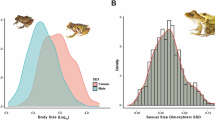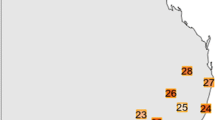Abstract
The springtail Gomphiocephalus hodgsoni (Arthropoda: Collembola) has been the focus of extensive ecophysiological and molecular genetic work and is now arguably the most well-studied of the continental Antarctic springtails. Here, we further the ecophysiological catalogue of this species. First, we provide experimental data on G. hodgsoni from one summer season at Cape Bird (Ross Sea Region) examining dispersal ability and desiccation tolerance. Next, we expand an existing metabolic rate dataset that encompasses individual metabolic rate measurements across both temporal and spatial scales in southern Victoria Land, adding an additional season of metabolic rate measurements taken at a cooler, drier continental location (Garwood Valley). Our data show that some G. hodgsoni individuals can survive at least ten days of suspension on the surface of both fresh and sea water. This, coupled with the presence of G. hodgsoni specimens in air and pitfall traps suggests that dispersal over local scales (i.e. metres) is possible for this species. Our metabolic data show that different populations within the same Antarctic region have different average metabolic rates at both temporal and spatial scales, indicating that distinct populations may respond differently to environmental variables. We suggest that G. hodgsoni maintains a flexible life history strategy that allows its ecophysiological response(s) to be dependent on local environmental conditions. Accordingly, there may be no ‘typical’ response to environmental changes—a factor that should be considered in both future ecophysiological work and conservation approaches.








Similar content being viewed by others
References
Addo-Bediako A, Chown SL, Gaston KJ (2002) Metabolic cold adaptation in insects: a large scale perspective. Funct Ecol 16:332–338
Block W (1981) Terrestrial arthropods and low temperature. Cryobiology 18:436–444
Block W (1990) Cold tolerance of insects and other arthropods. Philos T Roy Soc B 326:613–633
Block W (1994) Terrestrial ecosystems: Antarctica. Polar Biol 14:293–300
Block W, Harrisson PM (1995) Collembolan water relations and environmental change in the maritime Antarctic. Global Change Biol 1:347–359
Block W, Tilbrook PJ (1975) Respiration studies on the Antarctic collembolan Cryptopygus antarcticus. Oikos 26:15–25
Block W, Tilbrook PJ (1978) Oxygen uptake by Cryptopygus antarcticus (Collembola) at South Georgia. Oikos 30:61–67
Block W, Sømme L, Ring R, Ottesen P, Worland MR (1988) Adaptations of arthropods to the sub-Antarctic environment. Brit Antarct Surv B 81:65–67
Block W, Harrisson PM, Vannier G (1990) A comparative study of relative water loss from two Antarctic springtails (Insecta, Collembola). J Insect Physiol 36:181–187
Clarke A (1993) Seasonal acclimation and latitudinal compensation in metabolism: do they exist? Funct Ecol 7:139–149
Convey P (1996) The influence of environmental characteristics on life history attributes of Antarctic terrestrial biota. Biol Rev 71:191–225
Convey P, Gibson JAE, Hillenbrand C-D, Hodgson DA, Pugh PJA, Smellie JL, Stevens MI (2008) Antarctic terrestrial life–challenging the history of the frozen continent? Biol Rev 83:103–117
Convey P, Stevens MI, Hodgson DA, Smellie JL, Hillenbrand C-D, Barnes DKA, Clarke A, Pugh PJA, Linse K, Cary SC (2009) Exploring biological constraints on the glacial history of Antarctica. Quat Sci Rev 28:3035–3048
Coulson SJ, Birkemoe T (2000) Long-term cold tolerance in Arctic invertebrates: recovery after 4 years at below −20°C. Can J Zoolog 78:2055–2058
Coulson SJ, Hodkinson ID, Webb NR, Harrison JA (2002) Survival of terrestrial soil-dwelling arthropods on and in seawater: implications for trans-oceanic dispersal. Funct Ecol 16:353–356
Davidson MM, Broady PA (1996) Analysis of gut contents of Gomphiocephalus hodgsoni Carpenter (Collembola: Hypogastruridate) at Cape Geology, Antarctica. Polar Biol 16:463–467
Elnitsky MA, Benoit JB, Denlinger DL, Lee RE Jr (2008) Desiccation tolerance and drought acclimation in the Antarctic collembolan Cryptopygus antarcticus. J Insect Physiol 54:1432–1439
Fanciulli PP, Summa D, Dallai R, Frati F (2001) High levels of genetic variability and population differentiation in Gressittacantha terranova (Collembola, Hexapoda) from Victoria Land, Antarctica. Antarct Sci 13:246–254
Frati F, Spinsanti G, Dallai R (2001) Genetic variation of mtCOII gene sequences in the collembolan Isotoma klovstadi from Victoria Land, Antarctica: evidence for population differentiation. Polar Biol 24:934–940
Gressitt JL, Larch RE, O’Brien CW (1960) Trapping air-borne insects in the Antarctic area. Pac Insects 2:245–250
Harrisson PM, Rothery P, Block W (1991) Drying processes in the Antarctic collembolan Cryptopygus antarcticus (Willem). J Insect Physiol 37:883–890
Hawes TC, Worland MR, Convey P, Bale JS (2007) Aerial dispersal of springtails on the Antarctic Peninsula: implications for local distribution and demography. Antarct Sci 19:3–10
Hawes TC, Worland MR, Bale JS, Convey P (2008) Rafting in Antarctic Collembola. J Zool 274:44–50
Hayward SAL, Worland MR, Convey P, Bale JS (2004) Effects of moisture on the local distribution of the Antarctic Collembola Cryptopygus antarcticus and Friesea grisea. Soil Biol Biochem 36:927–934
Janetschek H (1967) Arthropod ecology of South Victoria Land. In: Gressitt JL (ed) Entomology of Antarctica. American Geophysical Union, Washington DC, pp 205–293
Kennedy AD (1993) Water as a limiting factor in the Antarctic terrestrial environment—a biogeographical synthesis. Arctic Alpine Res 25:308–315
McGaughran A, Hogg ID, Stevens MI (2008) Patterns of population structure for springtails and mites in southern Victoria Land, Antarctica. Mol Phylogenet Evol 46:606–618
McGaughran A, Redding GP, Stevens MI, Convey P (2009) Temporal metabolic rate variation in an Antarctic springtail. J Insect Physiol 55:129–134
McGaughran A, Torricelli G, Carapelli A, Frati F, Stevens MI, Convey P, Hogg ID (2010a) Contrasting phylogeographic patterns for springtails reflect different evolutionary histories between the Antarctic Peninsula and continental Antarctica. J Biogeogr 37:103–119
McGaughran A, Convey P, Redding GP, Stevens MI (2010b) Temporal and spatial metabolic rate variation in the Antarctic springtail Gomphiocephalus hodgsoni. J Insect Physiol 56:57–64
McGaughran A, Convey P, Stevens MI, Chown SL (2010c) Metabolic rate, genetic and microclimate variation among springtail populations from sub-Antarctic Marion Island. Polar Biol 33:909–918
Nkem JN, Wall DH, Virginia RA, Barrett JE, Broos EJ, Porazinska DL, Adams BJ (2006) Wind dispersal of soil invertebrates in the McMurdo Dry Valleys, Antarctica. Polar Biol 29:346–352
Nolan L, Hogg ID, Stevens MI, Haase M (2006) Fine scale distribution of mtDNA haplotypes for the springtail Gomphiocephalus hodgsoni (Collembola) corresponds to an ancient shoreline in Taylor Valley, continental Antarctica. Polar Biol 29:813–819
Peck LS, Convey P, Barnes DKA (2006) Environmental constraints on life histories in Antarctic ecosystems: tempos, timings and predictability. Biol Rev 81:75–109
Pugh PJA, Convey P (2008) Surviving out in the cold: Antarctic endemic invertebrates and their refugia. J Biogeogr 35:2176–2186
Sinclair BJ, Sjursen H (2001) Cold tolerance of the Antarctic springtail Gomphiocephalus hodgsoni (Collembola, Hypogastruridae). Antarct Sci 13:271–279
Sinclair BJ, Terblanche JS, Scott MB, Blatch GL, Klok CJ, Chown SL (2006) Environmental physiology of three species of Collembola at Cape Hallett, North Victoria Land, Antarctica. J Insect Physiol 52:29–50
Stevens MI, Hogg ID (2002) Expanded distributional records of Collembola and Acari in southern Victoria Land, Antarctica. Pedobiologia 46:485–496
Stevens MI, Hogg ID (2003) Long-term isolation and recent range expansion revealed for the endemic springtail Gomphiocephalus hodgsoni from southern Victoria Land, Antarctica. Mol Ecol 12:2357–2369
Testerink GJ (1983) Metabolic adaptations to seasonal changes in humidity and temperature in litter-inhabiting Collembola. Oikos 40:234–240
Wise KAJ, Gressitt JL (1965) Far southern animals and plants. Nature 207:101–102
Wise KAJ, Spain AV (1967) Entomological investigations in Antarctica 1963–64 season. Pac Insects 9:271–293
Worland MR, Block W (2003) Desiccation at sub-zero temperatures in polar terrestrial arthropods. J Insect Physiol 49:193–203
Worland MR, Convey P (2001) Rapid cold hardening in Antarctic microarthropods. Funct Ecol 15:515–524
Worland MR, Lukešová A (2000) The effect of feeding on specific soil algae on the cold tolerance of two Antarctic microarthropods (Alaskozetes antarcticus and Cryptopygus antarcticus). Polar Biol 23:766–774
Zinkler D (1966) Vergleichende untersuchungen zur atmungs-physiologie von Collembolen (Apterygota) und andereen bodenkleinarthropoden. Z Vergleichende Physiol 52:99–144
Acknowledgments
We thank Laurie Beth Connell and two anonymous reviewers for their constructive comments on an earlier version of the manuscript. We are also grateful to Antarctica New Zealand for their logistical support. Funding for this project was provided by a New Zealand Tertiary Education Commission Top Achiever Doctoral Scholarship and a Sir Robin Irvine Doctoral Scholarship to AM, with the latter also supporting PC’s fieldwork; and by a New Zealand Foundation for Research Science and Technology Grant (UOWX0710) to IH. This paper forms a contribution to SCAR’s Evolution and Biodiversity in the Antarctic (EBA), Antarctica New Zealand’s Latitudinal Gradient Project (LGP), and British Antarctic Survey’s Polar Science for Planet Earth (PSPE) research programmes.
Author information
Authors and Affiliations
Corresponding author
Additional information
This article is an invited contribution on Global Tipping Points (Global Change and Antarctic Terrestrial Biodiversity) and part of the SCAR EBA programme. I. Hogg and D. Wall (Guest Editors).
Rights and permissions
About this article
Cite this article
McGaughran, A., Hogg, I.D. & Convey, P. Extended ecophysiological analysis of Gomphiocephalus hodgsoni (Collembola): flexibility in life history strategy and population response. Polar Biol 34, 1713–1725 (2011). https://doi.org/10.1007/s00300-011-1001-6
Received:
Revised:
Accepted:
Published:
Issue Date:
DOI: https://doi.org/10.1007/s00300-011-1001-6




